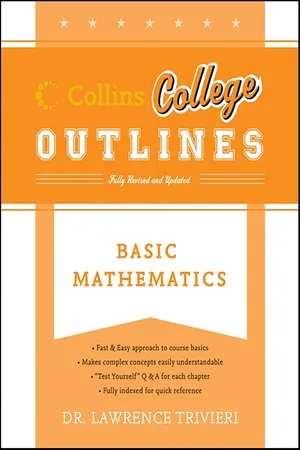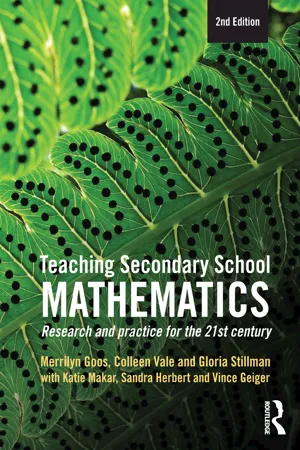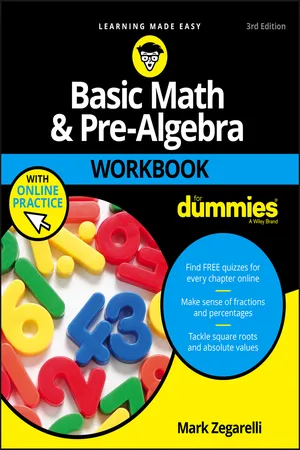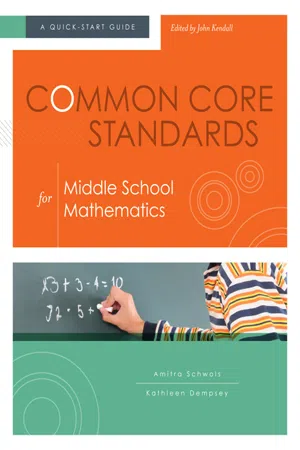Mathematics
Variables in Algebra
In algebra, variables are symbols used to represent unknown or changing quantities. They are typically denoted by letters such as x, y, or z. Variables can be manipulated and combined using mathematical operations to solve equations and express relationships between quantities.
Written by Perlego with AI-assistance
Related key terms
Related key terms
1 of 4
Related key terms
1 of 3
5 Key excerpts on "Variables in Algebra"
- No longer available |Learn more
- Lawrence A. Trivieri(Author)
- 2011(Publication Date)
- Collins Reference(Publisher)
CHAPTER 11An Introduction to Algebra
I n this chapter, we introduce algebra as a generalization of arithmetic. In algebra, we use letters to represent numbers. Algebraic expressions are discussed, including evaluating and combining them. Removing symbols of grouping is also discussed. In addition, the language of algebra is introduced. Linear equations in a single variable is also discussed, together with the applied problems they can help solve.11.1 EVALUATING ALGEBRAIC EXPRESSIONS In this section, you learn to classify algebraic expressions as sums or products and to evaluate an algebraic expression. ALGEBRAIC EXPRESSIONSIn algebra, letters are used to represent numbers. Such letters are called variables. The numbers are called constants. For example, in the expression × + 3y, the constant is 3; the variables are x and y . An algebraic expression is an expression that consists of constants and variables. Operation symbols and grouping symbols may also be included in the expression.The following are algebraic expressions:- x + y 2 + z3
- –2a +3bc
- 5m 3 – 3q5
- –7xyz
- u 3 –8u + u +
For our purposes, a difference is treated as an algebraic sum. Hence, x – y means x + (–y ). The expression 3u – 2v is called a sum of two terms, which are 3u and – 2v .- The algebraic expression 4t 2 – 3t can be written as 4t 2 + (–3t ). The constants are 4, 2, and –3; the variable is t
- The algebraic expression 3s 4 – 2s – 3 + can be written as 3s 4 + (–2s ) + (–3)
- The constants are 3, –2, and – 3; the variable is s .
In an algebraic expression, a term is part of a sum. Terms are separated by + or – signs. A factor is part of a product.Exercise 11.1Determine whether each of the following expressions is a sum or a product. If a sum, determine the number of terms; if a product, determine the number of factors. - eBook - ePub
Teaching Secondary School Mathematics
Research and practice for the 21st century
- Merrilyn Goos, Gloria Stillman, Sandra Herbert, Vince Geiger(Authors)
- 2020(Publication Date)
- Routledge(Publisher)
I drew graphs y = -1 and y = x 2 - 2x. They intersect in only one place, at x = 1. Caria: x= 1. I substituted a range of values forx in the equation and 1 is the only one that works. Source: Adapted from Adler and Davis (2006, p. 273). Zbiek and Heid (2008) called for teachers to consider different ways of learning about algebra, with tasks that encourage students to look for patterns and allow different problem- solving strategies using technology to connect representations and encourage deeper thinking and appreciate the power of symbols. The language of technology quite naturally depends on the concepts of variable and function. However, the concepts of variable and function in a technological world are much richer than those found in current school textbooks or in the minds of today’s students. The search for variable values that satisfy equations need no longer be the unquestioned and primary goals of beginning algebra. In a technological world, both functions and variables take on new meanings, as they are no longer seen as mere abstract notions in the classroom— especially in the context of exploring real-world phenomena. ‘Variables represent quantities that change, and algebra is the study of relationships among these changing quantities. What was the search for fixed values that fit statically defined relationships is now the dynamic exploration of mathematical relationships’ (Heid, 1995, p. 1). REVIEW AND REFLECT: With other students, draw a concept map of your understanding of function as developed through secondary school. Make sure you label object and procedural links (e.g., a link from ‘graph of function’ to ‘gradient’ could be labelled as ‘graph of function’ HAS A ‘gradient’ [an object link] or IS USED TO FIND a ‘gradient at a point’ [a procedural link]) - eBook - ePub
- Camilla Gilmore, Silke M. Göbel, Matthew Inglis(Authors)
- 2018(Publication Date)
- Routledge(Publisher)
functional approaches) involve referring to other domains, such as real-world examples or graphs and tables. In this way meaning is brought into the manipulation of algebraic representations.Both approaches have received some support from theorists, and interven-tions, including computer software, have been developed within both frame-works. However, rigorous comparisons of these approaches are lacking and therefore we don’t know which approach leads to deeper algebraic thinking, or whether children differ in which approach they find more beneficial.8.2 The concept of a variableOne of the major stumbling blocks when children learn algebra is understanding the concept of a variable and how to interpret literal symbols in algebraic expressions. Children frequently misinterpret the role of letters in expressions and may think that they stand for names of objects, or that the value corresponds to the position in the alphabet (i.e. a = 1, b = 2, c = 3, etc.). - Mark Zegarelli(Author)
- 2017(Publication Date)
- For Dummies(Publisher)
Part 4 The X Factor: Introducing Algebra IN THIS PART… Evaluate algebraic expressions by plugging in numbers for variables. Simplify expressions by removing parentheses and combining like terms. Factor expressions using the greatest common factor of all the terms. Solve algebraic equations by isolating the variable. Use cross-multiplication to solve equations with fractions. Chapter 14 Expressing Yourself with Algebraic Expressions IN THIS CHAPTER Evaluating algebraic expressions Breaking an expression into terms and identifying like terms Applying the Big Four operations to algebraic terms Simplifying and FOILing expressions In arithmetic, sometimes a box, a blank space, or a question mark stands for an unknown number, as in,, or. But in algebra, a letter such as x stands for an unknown number. A letter in algebra is called a variable because its value can vary from one problem to the next. For instance, in the equation, x has a value of 2 because. But in the equation, x has a value of 6 because. Here are a few algebra conventions you should know: Multiplication: When multiplying by a variable, you rarely use the multiplication operator. As in arithmetic, you can use parentheses without an operator to express multiplication. For example, 3(x) means. Often, the multiplication operator is dropped altogether. For example, 3 x means Division: The fraction bar replaces the division sign, so to express, you write. Powers: Algebra commonly uses exponents to show a variable multiplied by itself. So to express, you write x 2 rather than xx. To express xxx, you write x 3. An exponent applies only to the variable that it follows, so in the expression 2 xy 2, only the y is squared. To make the exponent apply to both variables, you’d have to group them in parentheses, as in 2(xy) 2. In this chapter, you find out how to read, evaluate, break down, and simplify basic algebraic expressions- eBook - ePub
Common Core Standards for Middle School Mathematics
A Quick-Start Guide
- Amitra Schwols, Kathleen Dempsey, John Kendall, John Kendall(Authors)
- 2013(Publication Date)
- ASCD(Publisher)
Chapter 4Expressions and Equations
. . . . . . . . . . . . . . . . . . . .The introduction to the Common Core standards' high school Algebra domain provides some useful definitions to help differentiate the two mathematical terms expression and equation:An expression is a record of a computation with numbers, symbols that represent numbers, arithmetic operations, exponentiation, and, at more advanced levels, the operation of evaluating a function…. An equation is a statement of equality between two expressions, often viewed as a question asking for which values of the variables the expressions on either side are in fact equal. These values are the solutions to the equation. (CCSSI, 2010c, p. 62)The middle school Expressions and Equations (EE) domain provides a critical bridge between content in the Operations and Algebraic Thinking domain in earlier grades and algebraic content students will encounter in high school. Figure 4.1 shows an overview of the Expressions and Equations domain's clusters and standards by grade level.
Index pages curate the most relevant extracts from our library of academic textbooks. They’ve been created using an in-house natural language model (NLM), each adding context and meaning to key research topics.
Explore more topic indexes
Explore more topic indexes
1 of 6
Explore more topic indexes
1 of 4




